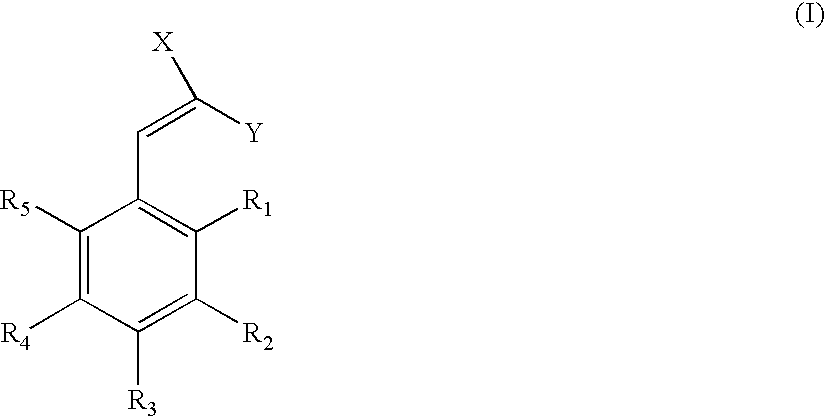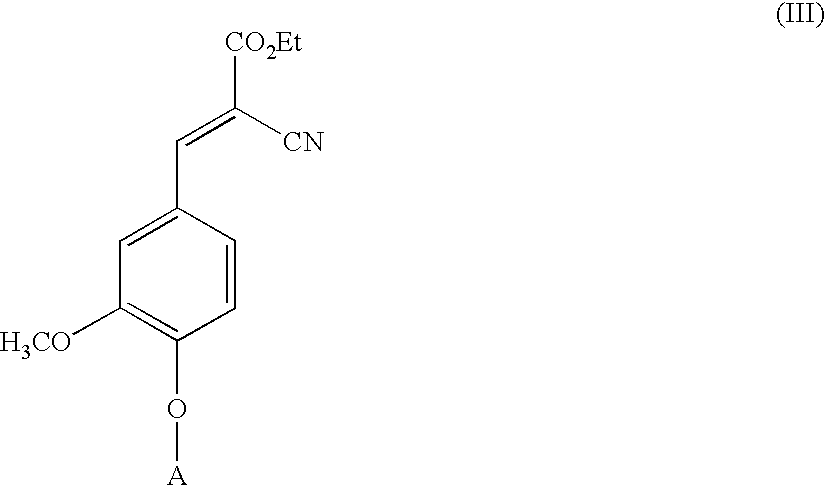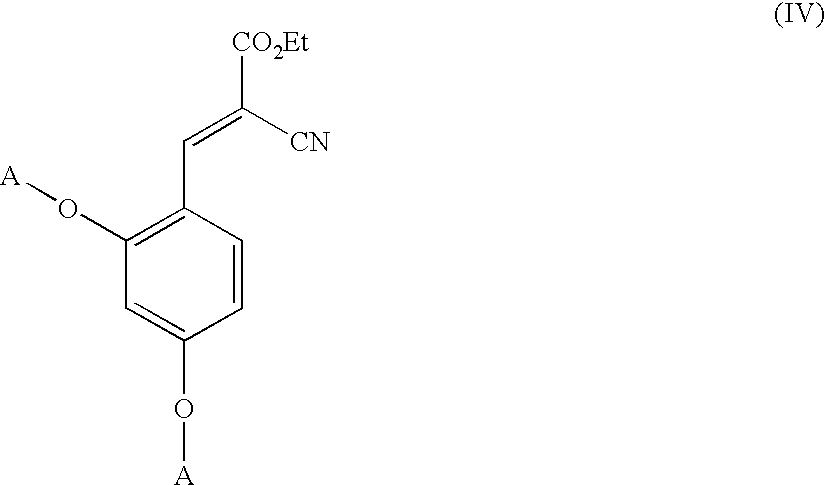Low-color ultraviolet absorbers for high UV wavelength protection applications
- Summary
- Abstract
- Description
- Claims
- Application Information
AI Technical Summary
Benefits of technology
Problems solved by technology
Method used
Image
Examples
example 1
[0048] Two thousand two hundred and eighty grams of vanillin, 20 g of lanthanum phosphate catalyst were charged to an autoclave. The autoclave was then sealed, purged several times with nitrogen gas (to a pressure of 60 PSIG) and then pressurized to 5 PSIG of nitrogen. After heating the autoclave to 121.degree. C., ethylene oxide was added to the reaction mixture until a total of 3960 g were added over time. Once all of the ethylene oxide was added, the mixture was post-cooked for a total of thirty minutes. The mixture was then cooled to 93.degree. C. and stripped at reduced pressure for fifteen minutes in order to remove un-reacted ethylene oxide. The product is a pale yellow liquid with a hydroxyl number of 134.
[0049] Nine hundred and thirty eight grams of 4-polyoxyalkylene-3-methoxy--benzaldehyde from the reaction described above, 30 g of Vitamin E, 8 g of glycine, 150 g of water and 305 g of ethyl cyanoacetate were charged to a 5 liter three neck round bottom flask. In the prese...
example 2
[0051] Four hundred and fifty-six grams of vanillin, one gram of KOH flake and four grams of proton sponge [1,8-bis(dimethylamino)naphthalene] were charged to an autoclave. The autoclave was then sealed, purged several times with nitrogen gas (to a pressure of 60 PSIG) and then pressurized to 5 PSIG of nitrogen. After heating the autoclave to 121.degree. C., ethylene oxide was added to the reaction mixture until a total of 792 g were added over time. Once all of the ethylene oxide was added, the mixture was post-cooked for a total of thirty minutes. The mixture was then cooled to 93.degree. C. and stripped at reduced pressure for fifteen minutes in order to remove un-reacted ethylene oxide. One thousand two hundred and fifty-three grams of product (yield 97%) is obtained as a pale yellow liquid with a hydroxyl number of 142.
[0052] 100.4 grams of 4-polyoxyalkylene-3-methoxy-benzaldehyde from the reaction described above, 0.82 g of Vitamin E, 0.92 g of glycine, 20 g of water and 26.3 ...
example 3
[0054] One thousand eight hundred and thirty grams of 4-hydroxybenzaldehyde, 20 g of lanthanum phosphate catalyst (as used above in EXAMPLE 1) were charged to an autoclave. The autoclave was then sealed, purged several times with nitrogen gas (to a pressure of 60 PSIG) and then pressurized to 5 PSIG of nitrogen. After heating the autoclave to 121.degree. C., ethylene oxide was added to the reaction mixture until a total of 3960 g were added over time. Once all of the ethylene oxide was added, the mixture was post-cooked for a total of thirty minutes. The mixture was then cooled to 93.degree. C. and vacuum stripped for fifteen minutes in order to remove unreacted ethylene oxide. The product is a pale yellow liquid with a hydroxyl number of 144.
[0055] Eight hundred sixty grams of 4-polyoxyalkylene-benzaldehyde from the reaction described above, 30 g of Vitamin E, 8 g of glycine, 150 g of water and 305 g of ethyl cyanoacetate were charged to a 5 liter three neck round bottom flask. In ...
PUM
| Property | Measurement | Unit |
|---|---|---|
| Fraction | aaaaa | aaaaa |
| Time | aaaaa | aaaaa |
| Thickness | aaaaa | aaaaa |
Abstract
Description
Claims
Application Information
 Login to View More
Login to View More - R&D
- Intellectual Property
- Life Sciences
- Materials
- Tech Scout
- Unparalleled Data Quality
- Higher Quality Content
- 60% Fewer Hallucinations
Browse by: Latest US Patents, China's latest patents, Technical Efficacy Thesaurus, Application Domain, Technology Topic, Popular Technical Reports.
© 2025 PatSnap. All rights reserved.Legal|Privacy policy|Modern Slavery Act Transparency Statement|Sitemap|About US| Contact US: help@patsnap.com



